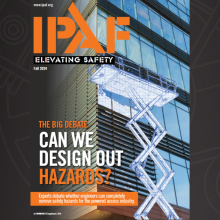The employer should ensure that all Operators using the equipment are trained to operate the MCWP, with full knowledge of the controls of the equipment, safety systems and emergency procedures, risk assessment guidance and they are able to carry out pre-use/daily inspections and perform the emergency descent. The employer should also ensure that all Operators receive adequate machine-specific familiarization, which should be conducted by a competent Demonstrator with the correct certifications, to ensure operators understand the specific machine controls and safety systems.
Demonstrators are persons, with full knowledge on the operating commands of the equipment, they are able to perform the emergency descent, carry out pre-use/daily and weekly inspections and ensuring that these take place.
In addition, they are trained in the demonstration of MCWP to others in a documented scheme, to ensure Operators understand the specific machine controls and safety systems.
The responsibility for determining the training needs of persons in respect of safety, and for making the necessary arrangements for training, rests with the individual employer. In the case of self-employed persons, the responsibility rests with themselves.
IPAF training programs include MCWP Operator and MCWP Demonstrator, and its successful completion at an IPAF-approved training center leads to a PAL Card, the highest international standard of quality training.

 Oops!
Oops!